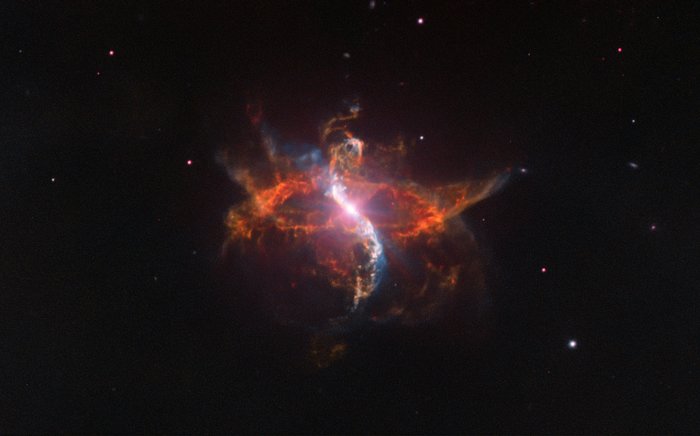VLT optagelse af R Aquarii fra 2012
Billedet viser det dramatiske binære stjernesystem, som kaldes R Aquarii, og som befinder sig 700 lysår fra Jorden. Billdet er optaget i 2012 med ESOs Very Large Telescope (VLT).
Stjernesystemet R Aquarii er en symbiotisk binær stjerne, som er omgivet af en stor dynamisk nebula - en gaståge. Denne type binære stjerner omfatter to stjerner, som har et ulige og kompliceret samliv - en a hvid dværg og en rød kæmpe. Som et ret så ubehageligt eksempel på stjernekannibalisme, er den hvide dværg i gang med at slubre stof i sig fra dens større ledsager. Den forpinte røde kæmpe og den ustabile hvide dværg udspyr så fra tid til anden stof i nogle underlige sprøjt, buer og baner; det, som skaber de underlige former, som kan ses på disse billeder.
Imellem de to optrædende i denne kosmiske pas-de-deux foregår der en hel del. Den røde kæmpe er variabel, med en ændring i lysstyrken, som er 750 gange i løbet af et år og tre uger. Den svage tåge hedder Cederblad 211, og den menes at være resultatet af en voldsom novaeksplosion for 250 år siden. Man ser også en smal lodret s-formet struktur med bobler af supervarmt stof, som bevæger sig udad fra stjernen med en enorm hastighed på 600 til 850 kilometer pr sekund.
R Aquarii blev også fotograferet for 15 år siden, og masser af gange i den mellemliggende tid, for at følge de løbende forandringer. Systemet ændrer sig meget og ret indviklet, og det har både udvidet sig og udviklet sig en hel del i de senere år (et billede fra 1997 findes her,og en sammenligning imellem de to billeder er her).
Kilde:ESO
Om billedet
| Id: | potw1850a |
| Sprog: | da |
| Type: | Observation |
| Udgivelsesdato: | 10. december 2018 06:00 |
| Størrelse: | 1873 x 1166 px |
Om objektet
Baggrundsbilleder
Koordinater
| Position (RA): | 23 43 49.60 |
| Position (Dec): | -15° 17' 11.67" |
| Field of view: | 5.99 x 3.73 arcminutes |
| Orientering: | Nord er 0.1° venstre fra lodret |
Farver & filtre
| Bånd | Bølgelængde | Teleskop |
|---|---|---|
| Optisk O III | 500 nm | Very Large Telescope FORS2 |
| Optisk O II | 372 nm | Very Large Telescope FORS2 |
| Optisk H-alpha | 656 nm | Very Large Telescope FORS2 |

